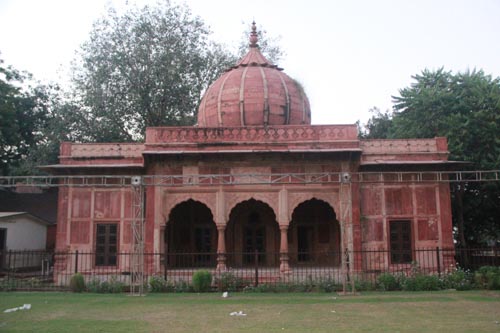Lal Bangla

Information on Lal Bangla (New Delhi) - History & Architecture
Lal Bangla is a complex which consists of two distinct burial places or rather tombs which are believed to hold the earthly remains of Lal Kunwar and Begum Jan. Lal Kunwar was the mother of the 18th Mughal Emperor, Shah Alam II and Begum Jan was his daughter. Each of the structures or the tombs includes two square shaped rooms that are positioned crosswise with rectangular walls running between them. The monument is presently managed by the Archaeological Survey of India (ASI). The adjoining enclosed spaces are believed to comprise the mausoleums of other family members of the Emperor Akbar II. It also includes the mausoleum of Sayyed Abid who was related to one of the chief soldiers of Shah Jahan. Lal Bangla is situated in the Delhi Golf Club complex area on Zakir Hussain Road, Delhi.
Lal Bangla Architecture
The two tombs are made of red coloured sand stone and are situated near the entrance of the complex which makes it visible from outside. The tombs were constructed during the period 1779 to 1780 and are regarded as Late Mughal monuments. These structures include a square shaped area at the crossways combined with rectangle walls running amid them along with domes in the middle of the roofs that are again square in shape. The structure close to the entrance is believed to be older and includes a rectangle room that is situated on an elevated plinth. Both the tombs are known to incorporate the arrangement of larger sized tombs in the region of the central compartment but those are found to be comparatively smaller in terms of size. The tombs are placed on a raised plinth which is made of red coloured sandstone which further connects the rooms at corners. The tombs have been constructed according to the Mughal pattern of architecture which is quite evident from the structure. The arched roof of the tombs signifies a typical characteristic of including an apex at the top which is innate to the Mughal style of architecture.
Lal Bangla History
Lal Bangla is regarded to be amongst the most outstanding and noteworthy structures of the Mughal period. Lal Bangla remains to be an interesting historical monument owing to the debatable matter regarding the identification of the characters lying buried under. Majority of the historical researches correspond that the mausoleum belongs to the daughter and mother of Mughal Emperor, Shah Alam. Shah Alam's daughter is known by the name of Begum Jaan and his mother is known as Nawab Zinat Mahal Sahiba or Lal Kunwar. The name Lal Kunwar supposedly confirms the reason of the name of the complex, Lal Bangla. However, there are other historians who contradict the mentioned possibility regarding the identification of the tombs and state that the tomb might be of Lal Kunwar who was the wife of Jahandar Shah, the son of Aurangazeb who possibly reigned over Delhi from the period 1712 to 1713. However, a shroud of mystery exists regarding the character of the royal lady which still remains an unsolved puzzle for the past two centuries. The other tomb located in the complex belongs to Sayyed Abid and has an octagonal shape with square interior.
Lal Bangla Tourism Significance
The Lal Bangla fails to attract significant number of tourists because of lack of information regarding the tombs. The other reason for lack of tourists is the fact that the Lal Bangla shares its area with the Delhi Golf Club and entry to it is just restricted to the club members which makes Lal Bangla inaccessible to the public.
- Andaman Nicobar Monuments
- Andhra Pradesh Monuments
- Assam Monuments
- Bihar Monuments
- Chhattisgarh Monuments
- New Delhi Monuments
- Goa Monuments
- Gujarat Monuments
- Haryana Monuments
- Himachal Pradesh Monuments
- Jammu and Kashmir Monuments
- Karnataka Monuments
- Kerala Monuments
- Madhya Pradesh Monuments
- Maharashtra Monuments
- Odisha Monuments
- Punjab Monuments
- Rajasthan Monuments
- Tamil Nadu Monuments
- Telangana Monuments
- Uttar Pradesh Monuments
- West Bengal Monuments